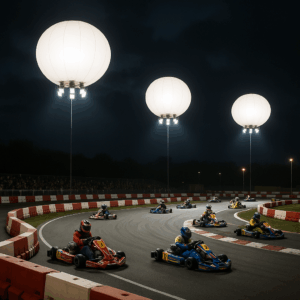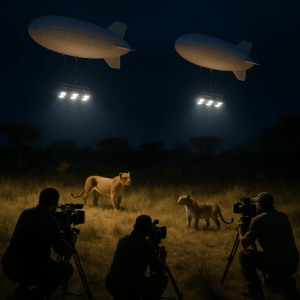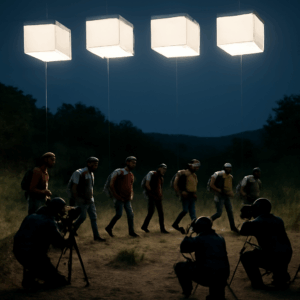Elevating Cinematic Lighting to New Heights
I. Introduction
Lighting is one of the most powerful tools in a filmmaker’s arsenal. It influences mood, enhances storytelling, and helps audiences emotionally connect with the visual narrative. For decades, lighting rigs have evolved—from tungsten and HMI setups to modern LED panels. But a new trend is literally taking lighting to the skies: helium balloon-mounted LED film lights.
Aerial lighting—once a logistical headache involving cranes or towers—is being reinvented. With helium balloons now acting as floating softboxes equipped with high-efficiency LEDs, filmmakers are discovering a whole new dimension of freedom, creativity, and efficiency. This blog explores the technology, advantages, and future of this revolutionary tool reshaping on-set lighting.
II. What Is Aerial Lighting in Film Production?
Aerial lighting refers to any lighting technique where the source is suspended above the set to provide top-down illumination. This can be used to simulate natural light sources like the sun or moon or to create soft, ambient lighting that doesn’t interfere with ground-level action.
Historically, this effect was achieved with boom lifts, condor cranes, or rigged lighting trusses, which required significant space, manpower, and safety precautions. In contrast, helium balloon LEDs provide the same (or better) coverage with minimal infrastructure, making them ideal for fast-paced productions or challenging environments.
III. Anatomy of a Helium Balloon LED System
Understanding how these systems work reveals why they are so versatile and appealing. A typical helium balloon LED system includes:
 IV. Key Advantages of Helium Balloon LEDs
IV. Key Advantages of Helium Balloon LEDs✅ A. Soft, Even Illumination from Above
One of the biggest strengths of helium balloon LEDs is their ability to produce natural-looking, omnidirectional light. Because the light is diffused through the balloon’s surface, the result is a soft wash of illumination that reduces harsh shadows and contrast. This makes them perfect for night exteriors, close-up dialogue, or emotive storytelling.
✅ B. Mobility and Flexibility on Set
Unlike traditional overhead setups that require large cranes or scaffolding, balloon lights can be relocated quickly and repositioned in tight spaces. Whether you’re shooting in a dense forest, on an urban rooftop, or on uneven terrain, these lights can be hoisted, floated, or tethered as needed.
✅ C. Minimal Footprint and Crew Requirement
Setup is remarkably efficient. In most cases, a helium balloon light can be fully deployed by one or two technicians in under 30 minutes. This drastically reduces time spent on lighting and frees up crew to focus on camera, talent, and direction.
✅ D. Energy Efficiency and Low Heat Output
Thanks to LED technology, balloon lights consume less power and generate minimal heat, creating a safer and more comfortable environment for cast and crew. Unlike HMIs, there’s no risk of burns, fire, or color drift due to overheating.
V. Use Cases in Modern Filmmaking
🌕 1. Nighttime Outdoor Scenes
Balloon LEDs are exceptional at simulating moonlight or skylight. Suspended high above a set, they provide a gentle overhead glow that mimics the real environment. Productions like The Revenant, 1917, and Game of Thrones have all used balloon lighting for expansive nighttime scenes.
🚓 2. Vehicle and Action Sequences
Lighting moving vehicles, car chases, or long stretches of road can be tricky. Mounting a balloon light on a vehicle rig or floating it along a track offers consistent illumination without interfering with the action. It eliminates the need for multiple relights or visible rigs in reflections.
🏙️ 3. Urban Filming Environments
City shoots come with strict regulations. Streetlights often aren’t enough, and rigging on public property can require permits. A balloon light allows for overhead coverage without touching infrastructure—ideal for guerrilla filmmaking or low-impact shoots.
🎭 4. Studio and Virtual Production
Inside soundstages, balloon lights can function as a giant ambient fill source, simulating skylight or large practicals. In virtual production, their consistent light quality and large surface area help integrate real actors with digital backdrops more seamlessly.
VI. Challenges and Limitations
⚠️ 1. Helium Supply and Cost
Helium, while effective, is a non-renewable gas and can be expensive or restricted in some regions. Productions may need to plan balloon use carefully or opt for air-inflated alternatives when possible.
🌬️ 2. Weather Sensitivity
Wind and rain can make balloon lights unstable. Most are rated for mild wind conditions only (below 25 km/h). Backup plans or anchor systems are crucial for outdoor shoots in unpredictable climates.
📏 3. Size and Storage
Large balloons require transport cases and inflation time. While smaller models are more portable, they may not provide sufficient brightness for large scenes.
⚖️ 4. Safety Regulations
Operating helium balloons—especially at height—may require local airspace approvals or safety inspections, particularly near airports or public areas.
VII. The Future of Aerial LED Lighting
As technology continues to evolve, so too will the applications of balloon-mounted LEDs. Here’s what’s coming next:
🚁 A. Drone-Mounted Balloons
The fusion of drones and balloon lighting is on the rise. With automated flight paths and gimbal-stabilized lights, aerial cinematography can now include floating light sources that track subjects in motion.
🎨 B. Advanced RGB and Pixel Control
Newer models offer zone-controlled LEDs across the balloon surface, enabling effects like fire flicker, police strobes, or dynamic gradients. Some systems support full pixel mapping using lighting consoles.
🤖 C. AI-Assisted Lighting Control
Future balloon systems may incorporate AI algorithms that adjust intensity, direction, and color based on camera movement, scene context, or actor position, allowing for fully adaptive lighting environments.
VIII. Why the Industry Is Embracing the Shift
With filmmaking becoming more dynamic, diverse, and digitally integrated, lighting must be flexible too. Helium balloon LEDs answer a growing demand for:
Whether you’re shooting an indie film, a music video, or a blockbuster, aerial lighting opens up new visual possibilities without the limits of traditional rigging or harsh light sources.
IX. Conclusion
The rise of aerial lighting—specifically LED film lights mounted on helium balloons—is more than a technical innovation; it’s a creative breakthrough. These systems allow filmmakers to light from above with precision, softness, and freedom previously reserved for the biggest productions.
By merging mobility, efficiency, and artistic control, helium balloon lights are not just elevating sets—they’re elevating storytelling.
So next time you’re lighting a scene, consider the sky. Your perfect shot might be just a few meters above your head.
–The End–
Get in touch for free lighting customization